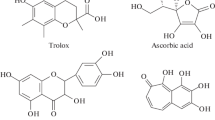Abstract
Luteolin, a water-insoluble 3′,4′,5,7-tetrahydroxyflavon, is one of the best-studied representatives of bioflavonoids. Luteolin is an essential food component for humans and other mammals that possesses a wide spectrum of biological activities by affecting the activities of various metabolic enzymes, target receptors, and signal transduction pathways. In this study, we conducted a comparative study of the antioxidant (free-radical scavenging) properties of luteolin in 2,2′-azobis(2-methylpropionamidine) dihydrochloride–luminol and hemoglobin–hydrogen peroxide–luminol systems and assessed its effect on the permeability of planar lipid bilayer membranes. Trolox was used as a reference antioxidant, while ascorbic acid and dihydroquercetin were taken as standards. Luteolin shows moderate antioxidant activity, exhibiting a higher antioxidant capacity than trolox and ascorbic acid, but it was less effective than dihydroquercetin in tests for antioxidant activity in the studied systems. The studied compounds can be ranked according to the effectiveness of their antioxidant action: dihydroquercetin > luteolin > trolox > ascorbic acid. It should be noted that the antioxidant activity of a water-soluble form of luteolin, luteolin disulfate, is comparable with that of luteolin. Luteolin does not cause significant changes in the permeability of planar bilayer membranes in the dose range from 1.5 to 30 μM. Our findings indicate the presence of a high level of free-radical scavenging activity and the absence of a primary membranotropic effect for luteolin. It can be assumed that the multiple pleiotropic nature of luteolin activity towards a variety of biological systems is associated not only with a neutralizing effect in regard to reactive oxygen species, but also with the ability of luteolin to block and modulate different cell-signaling processes and biochemical pathways. The presumed mechanisms of the biological activity of luteolin and luteolin disulfate are discussed.
Similar content being viewed by others
Abbreviations
- LT:
-
luteolin; dihydroquercetin
- DHQ:
-
2,2′-azobis(2-methylpropionamidine) dihydrochloride
- AAPH:
-
AOA, antioxidant activity
References
A. M. Popov, O. N. Krivoshapko, and A. A. Artyukov, Biofarmatsevt. Zh. 4 (4), 27 (2012).
M. Lopez-Lazaro, Mini-Rev. Med. Chem. 9 (1), 31 (2009).
A. M. Popov, O. N. Krivoshapko, A. A. Artyukov, Biofarmatsevt. Zh. 3 (4), 27 (2011).
A. M. Popov, O. N. Krivoshapko, A. A. Klimovich, et al., Biomed. Khim. 62 (1) 22 (2016)
Y. Sadzuka, T. Sugiyama, K. Shimoi, et al., Toxicol. Lett. 92, 1 (1997).
C. F. Lima, M. Fernandes-Ferreira, and C. Pereira-Wilson, Life Sci. 79 (21), 2056 (2006).
W. Ju, X. Wang, H. Shi, et al., Mol. Pharmacol. 71 (5), 1381 (2007).
L. Ziyan, Z. Yongmei, Z. Nan, et al., Planta Med. 73 (3), 221 (2007).
O. N. Krivoshapko, A. M. Popov, A. A. Artyukov, et al., Biochemistry (Moscow) Suppl. Ser. B: Biomed. Chemistry 5 (2) 152 (2011).
A. M. Popov, A. N. Osipov, E. A. Korepanova, et al., Biophysics 58 (5), 607 (2013).
A Hanneken, F. F. Lin, J. Johnson, and P. Maher, Invest. Ophthalmol. Vis. Sci. 47 (7), 3164 (2006).
H. Oh, D. H. Kim, J. H. Cho, et al., J. Ethnopharmacol. 95 (2–3), 421 (2004).
Author information
Authors and Affiliations
Corresponding author
Additional information
Original Russian Text © A.M. Popov, A.N. Osipov, E.A. Korepanova, O.N. Krivoshapko, A.A. Artyukov, A.A. Klimovich, 2016, published in Biofizika, 2016, Vol. 61, No. 6, pp. 1079–1087.
Rights and permissions
About this article
Cite this article
Popov, A.M., Osipov, A.N., Korepanova, E.A. et al. A study of the antioxidant and membranotropic activities of luteolin using different model systems. BIOPHYSICS 61, 843–850 (2016). https://doi.org/10.1134/S0006350916060221
Received:
Accepted:
Published:
Issue Date:
DOI: https://doi.org/10.1134/S0006350916060221



